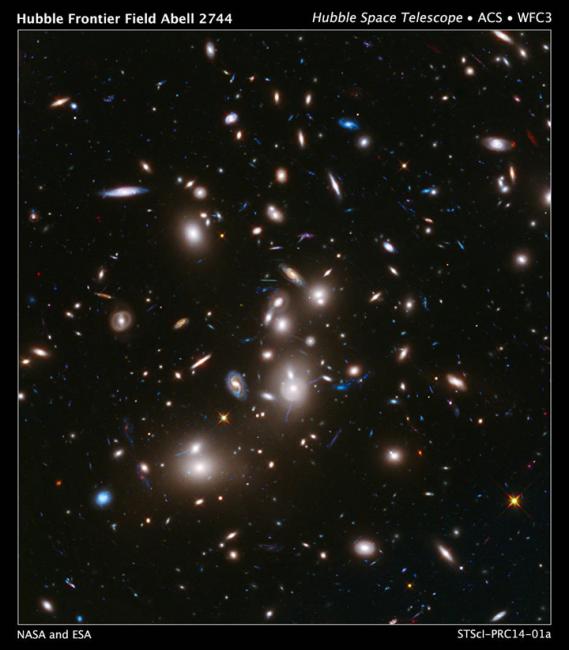
Abell 2744, a cluster of galaxies whose dark matter halo has imaged more distant galaxies as seen in this Hubble Space Telescope image. Astronomers have compared the image to simulations of dark matter lensing and found excellent agreement, indicating that that current models of dark matter behavior on the large scale are quite good.
About eighty-five percent of the matter in the universe is in the form of dark matter, whose nature remains a mystery. The rest of the matter in the universe is of the kind found in atoms. Astronomers studying the evolution of galaxies in the universe find that dark matter exhibits gravity and, because it is so abundant, it dominates the formation of large-scale structures in the universe like clusters of galaxies. Dark matter is hard to observe directly, needless to say, and it shows no evidence of interacting with itself or other matter other than via gravity, but fortunately it can be traced by modeling sensitive observations of the distributions of galaxies across a range of scales.
Galaxies generally reside at the centers of vast clumps of dark matter called haloes because they surround the clusters of galaxies. Gravitational lensing of more distant galaxies by dark matter haloes offers a particularly unique and powerful probe of the detailed distribution of dark matter. So-called strong gravitational lensing creates highly distorted, magnified and occasionally multiple images of a single source; so-called weak lensing results in modestly yet systematically deformed shapes of background galaxies that can also provide robust constraints on the distribution of dark matter within the clusters.
CfA astronomers Annalisa Pillepich and Lars Hernquist and their colleagues compared gravitationally distorted Hubble images of the galaxy cluster Abell 2744 and two other clusters with the results of computer simulations of dark matter haloes. They found, in agreement with key predictions in the conventional dark matter picture, that the detailed galaxy substructures depend on the dark matter halo distribution, and that the total mass and the light trace each other. They also found a few discrepancies: the radial distribution of the dark matter is different from that predicted by the simulations, and the effects of tidal stripping and friction in galaxies are smaller than expected, but they suggest these issues might be resolved with more precise simulations. Overall, however, the standard model of dark matter does an excellent and reassuring job of describing galaxy clustering.
"Mapping Substructure in the HST Frontier Fields Cluster Lenses and in Cosmological Simulations," Priyamvada Natarajan, Urmila Chadayammuri, Mathilde Jauzac, Johan Richard, Jean-Paul Kneib, Harald Ebeling, Fangzhou Jiang, Frank van den Bosch, Marceau Limousin, Eric Jullo, Hakim Atek, Annalisa Pillepich,Cristina Popa, Federico Marinacci, Lars Hernquist, Massimo Meneghetti, and Mark Vogelsberger, MNRAS 468, 1962, 2017.
Related News
CfA Astronomers Play Key Role in New Dark Energy Results
Active Galactic Nuclei and Galaxy Cluster Cooling
Astrophysicists Reveal Largest-Ever Suite of Universe Simulations
To Map the Universe, Astrophysicists Launch Largest Sky Survey Yet
Projects
2MASS Redshift Survey
AstroAI
GMACS
For Scientists